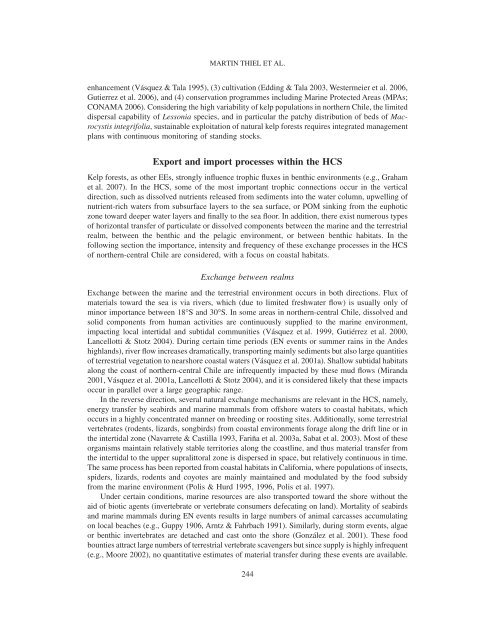the humboldt current system of northern and central chile - figema
the humboldt current system of northern and central chile - figema
the humboldt current system of northern and central chile - figema
Create successful ePaper yourself
Turn your PDF publications into a flip-book with our unique Google optimized e-Paper software.
MARTIN THIEL ET AL.enhancement (Vásquez & Tala 1995), (3) cultivation (Edding & Tala 2003, Westermeier et al. 2006,Gutierrez et al. 2006), <strong>and</strong> (4) conservation programmes including Marine Protected Areas (MPAs;CONAMA 2006). Considering <strong>the</strong> high variability <strong>of</strong> kelp populations in nor<strong>the</strong>rn Chile, <strong>the</strong> limiteddispersal capability <strong>of</strong> Lessonia species, <strong>and</strong> in particular <strong>the</strong> patchy distribution <strong>of</strong> beds <strong>of</strong> Macrocystisintegrifolia, sustainable exploitation <strong>of</strong> natural kelp forests requires integrated managementplans with continuous monitoring <strong>of</strong> st<strong>and</strong>ing stocks.Export <strong>and</strong> import processes within <strong>the</strong> HCSKelp forests, as o<strong>the</strong>r EEs, strongly influence trophic fluxes in benthic environments (e.g., Grahamet al. 2007). In <strong>the</strong> HCS, some <strong>of</strong> <strong>the</strong> most important trophic connections occur in <strong>the</strong> verticaldirection, such as dissolved nutrients released from sediments into <strong>the</strong> water column, upwelling <strong>of</strong>nutrient-rich waters from subsurface layers to <strong>the</strong> sea surface, or POM sinking from <strong>the</strong> euphoticzone toward deeper water layers <strong>and</strong> finally to <strong>the</strong> sea floor. In addition, <strong>the</strong>re exist numerous types<strong>of</strong> horizontal transfer <strong>of</strong> particulate or dissolved components between <strong>the</strong> marine <strong>and</strong> <strong>the</strong> terrestrialrealm, between <strong>the</strong> benthic <strong>and</strong> <strong>the</strong> pelagic environment, or between benthic habitats. In <strong>the</strong>following section <strong>the</strong> importance, intensity <strong>and</strong> frequency <strong>of</strong> <strong>the</strong>se exchange processes in <strong>the</strong> HCS<strong>of</strong> nor<strong>the</strong>rn-<strong>central</strong> Chile are considered, with a focus on coastal habitats.Exchange between realmsExchange between <strong>the</strong> marine <strong>and</strong> <strong>the</strong> terrestrial environment occurs in both directions. Flux <strong>of</strong>materials toward <strong>the</strong> sea is via rivers, which (due to limited freshwater flow) is usually only <strong>of</strong>minor importance between 18°S <strong>and</strong> 30°S. In some areas in nor<strong>the</strong>rn-<strong>central</strong> Chile, dissolved <strong>and</strong>solid components from human activities are continuously supplied to <strong>the</strong> marine environment,impacting local intertidal <strong>and</strong> subtidal communities (Vásquez et al. 1999, Gutiérrez et al. 2000,Lancellotti & Stotz 2004). During certain time periods (EN events or summer rains in <strong>the</strong> Andeshighl<strong>and</strong>s), river flow increases dramatically, transporting mainly sediments but also large quantities<strong>of</strong> terrestrial vegetation to nearshore coastal waters (Vásquez et al. 2001a). Shallow subtidal habitatsalong <strong>the</strong> coast <strong>of</strong> nor<strong>the</strong>rn-<strong>central</strong> Chile are infrequently impacted by <strong>the</strong>se mud flows (Mir<strong>and</strong>a2001, Vásquez et al. 2001a, Lancellotti & Stotz 2004), <strong>and</strong> it is considered likely that <strong>the</strong>se impactsoccur in parallel over a large geographic range.In <strong>the</strong> reverse direction, several natural exchange mechanisms are relevant in <strong>the</strong> HCS, namely,energy transfer by seabirds <strong>and</strong> marine mammals from <strong>of</strong>fshore waters to coastal habitats, whichoccurs in a highly concentrated manner on breeding or roosting sites. Additionally, some terrestrialvertebrates (rodents, lizards, songbirds) from coastal environments forage along <strong>the</strong> drift line or in<strong>the</strong> intertidal zone (Navarrete & Castilla 1993, Fariña et al. 2003a, Sabat et al. 2003). Most <strong>of</strong> <strong>the</strong>seorganisms maintain relatively stable territories along <strong>the</strong> coastline, <strong>and</strong> thus material transfer from<strong>the</strong> intertidal to <strong>the</strong> upper supralittoral zone is dispersed in space, but relatively continuous in time.The same process has been reported from coastal habitats in California, where populations <strong>of</strong> insects,spiders, lizards, rodents <strong>and</strong> coyotes are mainly maintained <strong>and</strong> modulated by <strong>the</strong> food subsidyfrom <strong>the</strong> marine environment (Polis & Hurd 1995, 1996, Polis et al. 1997).Under certain conditions, marine resources are also transported toward <strong>the</strong> shore without <strong>the</strong>aid <strong>of</strong> biotic agents (invertebrate or vertebrate consumers defecating on l<strong>and</strong>). Mortality <strong>of</strong> seabirds<strong>and</strong> marine mammals during EN events results in large numbers <strong>of</strong> animal carcasses accumulatingon local beaches (e.g., Guppy 1906, Arntz & Fahrbach 1991). Similarly, during storm events, algaeor benthic invertebrates are detached <strong>and</strong> cast onto <strong>the</strong> shore (González et al. 2001). These foodbounties attract large numbers <strong>of</strong> terrestrial vertebrate scavengers but since supply is highly infrequent(e.g., Moore 2002), no quantitative estimates <strong>of</strong> material transfer during <strong>the</strong>se events are available.244










